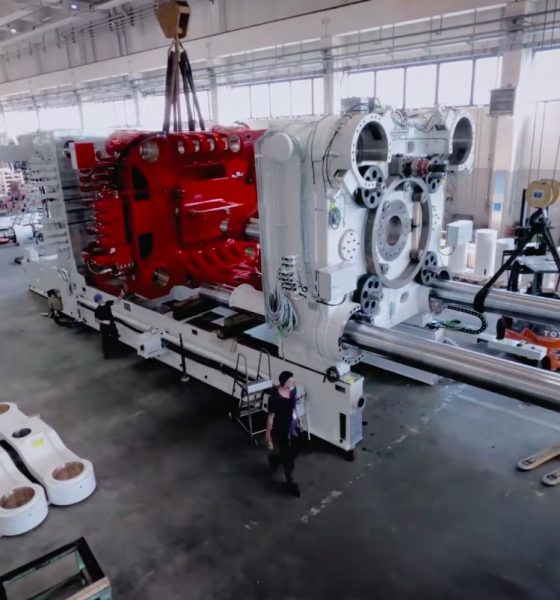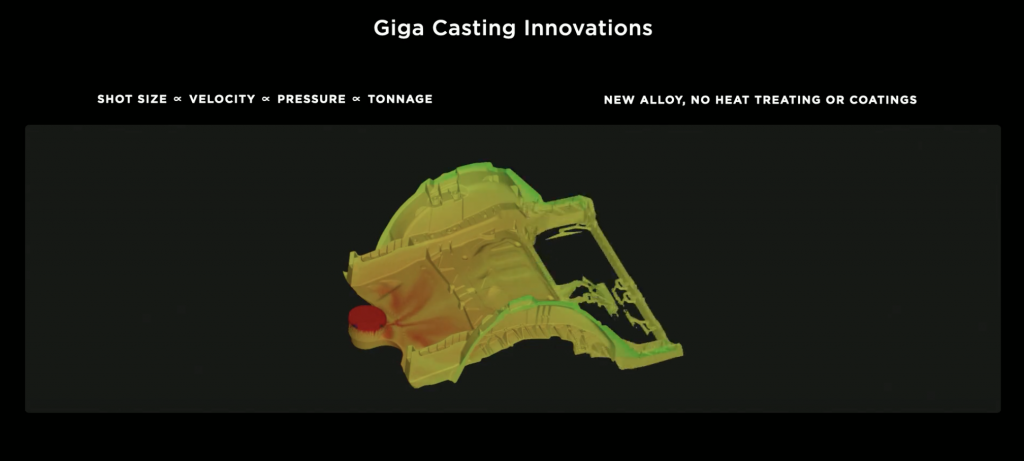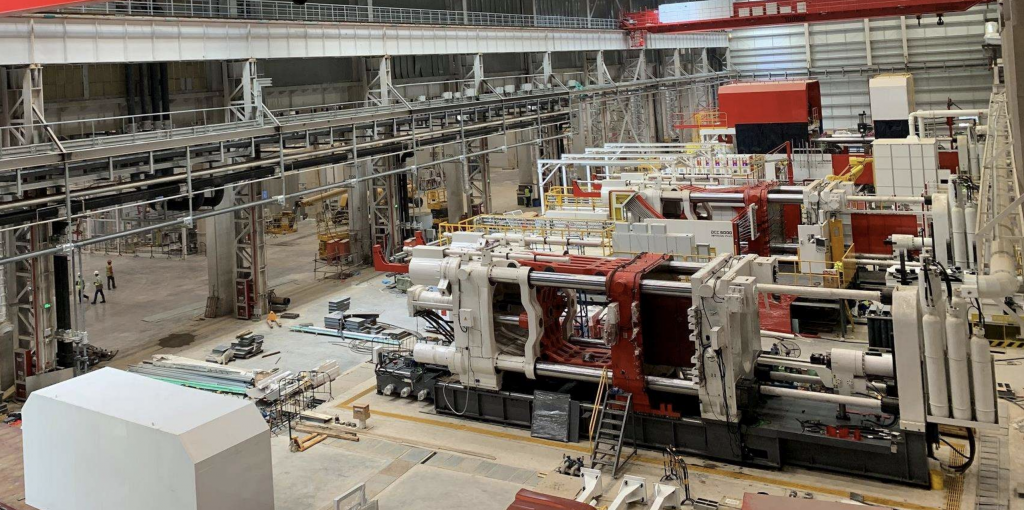

News
The Year of the ‘Giga Press’: How Tesla’s monster machines can complete Elon Musk’s 2nd Master Plan
One of the most exciting developments from Tesla eagerly awaited by the electric car community is the company’s use of its giant casting machines. Dubbed by its maker IDRA as the “Giga Press,” the house-sized monster machines are capable of producing single-cast pieces for Tesla’s vehicles, starting with the Model Y.
The Giga Press lives up to its name. Its physical footprint is formidable, measuring 20 meters x 7.5 meters x 6 meters. It also weighs a whopping 430 tons, or about five Space Shuttles. So massive is the Giga Press that it takes up to 24 flatbed trucks to transport its components.
When operating, the Giga Presses are no slouch, as they have a cycle time of ~80‒90 seconds, which translates to an output rate of 40‒45 completed castings per hour, or about ~1,000 castings per day. That’s over 300,000 castings per year, per machine.

A Platoon of Giga Presses
So far, Tesla has set up two Giga Presses on the grounds of the Fremont Factory. Flyovers of the site show that the two machines are already set up, though it remains to be seen when they would formally be deployed. Over in China, three other Giga Presses have been spotted in the Giga Shanghai complex, though the units were reportedly built by LK Machinery, IDRA’s parent company.
But what is rather remarkable is that Tesla has several more Giga Presses in order. Sandy Munro, in a recent interview with electric vehicle advocate Sean Mitchell, noted that he has heard through the grapevine that Tesla has ordered 11 more units of the Giga Presses. Previous reports point to Giga Berlin receiving eight of the machines, and flyovers at the Giga Texas site seem to reveal three isolation pits for the monster machines in the area.
Needless to say, the Giga Press is poised to become a key part of Tesla’s Gigafactories from now on. As Tesla rolls out its single-piece cast design for the vehicles in its lineup, the company’s platoon of Giga Press machines will likely play an even bigger role. This role will likely become prominent starting next year, 2021.

The Year of the Giga Press
Tesla has always been a rebel of sorts, and this became extremely prominent this year. 2020 will likely be known as the year when the world stopped, and automakers suffered deep wounds due to the pandemic. Tesla, being a company that has always swum against the current, thrived instead of dropped. It is even poised to end the year as the newest member of the S&P 500.
But 2020 is only the beginning of a new chapter in the Tesla story. With the company now on more stable footing, the electric car maker can focus on executing its ramp for 2021. This ramp would likely involve Tesla aiming to produce close to, or perhaps up to, a million vehicles in one year. Such a ramp would require the full deployment of its Giga Press machines.
There is little doubt that Giga Press No.1 and No.2 at the Fremont Factory will be deployed fully soon. Giga Press No.3, No.4, and No.5 at Gigafactory Shanghai will likely be operational in early 2021 as well. And with Gigafactory Berlin likely starting Model Y production sometime next year, there is a good chance that several of its Giga Presses would go live next year as well. These, as well as the speculated machines in the Cybertruck Gigafactory in Texas, should allow Tesla to turn 2021 into the year of the Giga Press.

A Multi-Segment Approach
Tesla is a company with a big goal, one which focuses on the Master Plan of its CEO. So far, Tesla has pretty much completed Elon Musk’s first Master Plan, but Part Deux still needs some worth to accomplish. This is especially true for one aspect of the CEO’s target—expanding the company’s vehicle product line to address all major segments.
So far, Tesla has vehicles that compete in the large sedan, midsize sedan, SUV, and crossover market. This is one of the reasons why there is still so much more for Tesla to do. Granted, the Cybertruck will address the pickup market, the Semi will address the long-haul segment, and the new Roadster will compete in the supercar market. But there are still other segments to tap. One of these is the compact car market, which is populated with small, low-cost vehicles that are extremely aggressively priced.
Tesla and Elon Musk have both noted that the company will be producing a $25,000 electric car that is smaller and cheaper than the Model 3. Such a vehicle would likely be equipped with the best innovations that the company can offer for it to be profitable. These include low-cost and disruptive tabless 4680 battery cells and massive single-piece casts that are produced with the Giga Press. And considering that both Giga Shanghai and Giga Berlin seem poised to produce the $25,000 Tesla, there seems to be a good chance that the company’s Giga Press platoon is only bound to get bigger in the near future.
Watch Sandy Munro and Sean Mitchell’s conversations about Tesla and its innovations in the video below.
Don’t hesitate to contact us for news tips. Just send a message to tips@teslarati.com to give us a heads up.

News
Tesla starts showing how FSD will change lives in Europe
Local officials tested the system on narrow country roads and were impressed by FSD’s smooth, human-like driving, with some calling the service a game-changer for everyday life in areas that are far from urban centers.

Tesla has launched Europe’s first public shuttle service using Full Self-Driving (Supervised) in the rural Eifelkreis Bitburg-Prüm region of Germany, demonstrating how the technology can restore independence and mobility for people who struggle with limited transport options.
Local officials tested the system on narrow country roads and were impressed by FSD’s smooth, human-like driving, with some calling the service a game-changer for everyday life in areas that are far from urban centers.
Officials see real impact on rural residents
Arzfeld Mayor Johannes Kuhl and District Administrator Andreas Kruppert personally tested the Tesla shuttle service. This allowed them to see just how well FSD navigated winding lanes and rural roads confidently. Kruppert said, “Autonomous driving sounds like science fiction to many, but we simply see here that it works totally well in rural regions too.” Kuhl, for his part, also noted that FSD “feels like a very experienced driver.”
The pilot complements the area’s “Citizen Bus” program, which provides on-demand rides for elderly residents who can no longer drive themselves. Tesla Europe shared a video of a demonstration of the service, highlighting how FSD gives people their freedom back, even in places where public transport is not as prevalent.
What the Ministry for Economic Affairs and Transport says
Rhineland-Palatinate’s Minister Daniela Schmitt supported the project, praising the collaboration that made this “first of its kind in Europe” possible. As per the ministry, the rural rollout for the service shows FSD’s potential beyond major cities, and it delivers tangible benefits like grocery runs, doctor visits, and social connections for isolated residents.
“Reliable and flexible mobility is especially vital in rural areas. With the launch of a shuttle service using self-driving vehicles (FSD supervised) by Tesla in the Eifelkreis Bitburg-Prüm, an innovative pilot project is now getting underway that complements local community bus services. It is the first project of its kind in Europe.
“The result is a real gain for rural mobility: greater accessibility, more flexibility and tangible benefits for everyday life. A strong signal for innovation, cooperation and future-oriented mobility beyond urban centers,” the ministry wrote in a LinkedIn post.
News
Tesla China quietly posts Robotaxi-related job listing
Tesla China is currently seeking a Low Voltage Electrical Engineer to work on circuit board design for the company’s autonomous vehicles.

Tesla has posted a new job listing in Shanghai explicitly tied to its Robotaxi program, fueling speculation that the company is preparing to launch its dedicated autonomous ride-hailing service in China.
As noted in the listing, Tesla China is currently seeking a Low Voltage Electrical Engineer to work on circuit board design for the company’s autonomous vehicles.
Robotaxi-specific role
The listing, which was shared on social media platform X by industry watcher @tslaming, suggested that Tesla China is looking to fill the role urgently. The job listing itself specifically mentions that the person hired for the role will be working on the Low Voltage Hardware team, which would design the circuit boards that would serve as the nervous system of the Robotaxi.
Key tasks for the role, as indicated in the job listing, include collaboration with PCB layout, firmware, mechanical, program management, and validation teams, among other responsibilities. The role is based in Shanghai.
China Robotaxi launch
China represents a massive potential market for robotaxis, with its dense urban centers and supportive policies in select cities. Tesla has limited permission to roll out FSD in the country, though despite this, its vehicles have been hailed as among the best in the market when it comes to autonomous features. So far, at least, it appears that China supports Tesla’s FSD and Robotaxi rollout.
This was hinted at in November, when Tesla brought the Cybercab to the 8th China International Import Expo (CIIE) in Shanghai, marking the first time that the autonomous two-seater was brought to the Asia-Pacific region. The vehicle, despite not having a release date in China, received a significant amount of interest among the event’s attendees.
Elon Musk
Elon Musk and Tesla AI Director share insights after empty driver seat Robotaxi rides
The executives’ unoccupied tests hint at the rapid progress of Tesla’s unsupervised Robotaxi efforts.

Tesla CEO Elon Musk and AI Director Ashok Elluswamy celebrated Christmas Eve by sharing personal experiences with Robotaxi vehicles that had no safety monitor or occupant in the driver’s seat. Musk described the system’s “perfect driving” around Austin, while Elluswamy posted video from the back seat, calling it “an amazing experience.”
The executives’ unoccupied tests hint at the rapid progress of Tesla’s unsupervised Robotaxi efforts.
Elon and Ashok’s firsthand Robotaxi insights
Prior to Musk and the Tesla AI Director’s posts, sightings of unmanned Teslas navigating public roads were widely shared on social media. One such vehicle was spotted in Austin, Texas, which Elon Musk acknowleged by stating that “Testing is underway with no occupants in the car.”
Based on his Christmas Eve post, Musk seemed to have tested an unmanned Tesla himself. “A Tesla with no safety monitor in the car and me sitting in the passenger seat took me all around Austin on Sunday with perfect driving,” Musk wrote in his post.
Elluswamy responded with a 2-minute video showing himself in the rear of an unmanned Tesla. The video featured the vehicle’s empty front seats, as well as its smooth handling through real-world traffic. He captioned his video with the words, “It’s an amazing experience!”
Towards Unsupervised operations
During an xAI Hackathon earlier this month, Elon Musk mentioned that Tesla owed be removing Safety Monitors from its Robotaxis in Austin in just three weeks. “Unsupervised is pretty much solved at this point. So there will be Tesla Robotaxis operating in Austin with no one in them. Not even anyone in the passenger seat in about three weeks,” he said. Musk echoed similar estimates at the 2025 Annual Shareholder Meeting and the Q3 2025 earnings call.
Considering the insights that were posted Musk and Elluswamy, it does appear that Tesla is working hard towards operating its Robotaxis with no safety monitors. This is quite impressive considering that the service was launched just earlier this year.








